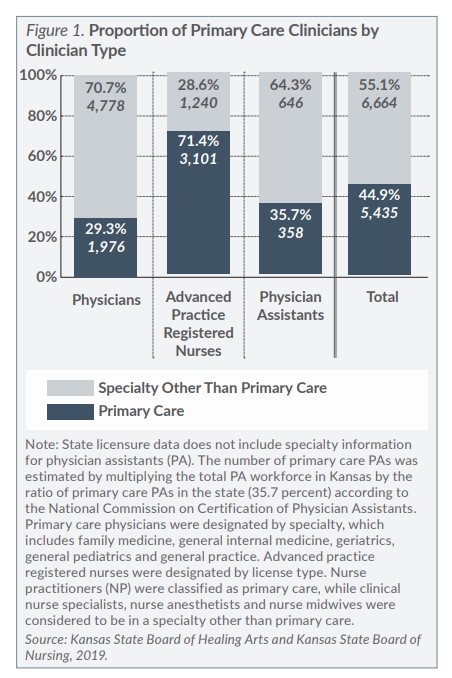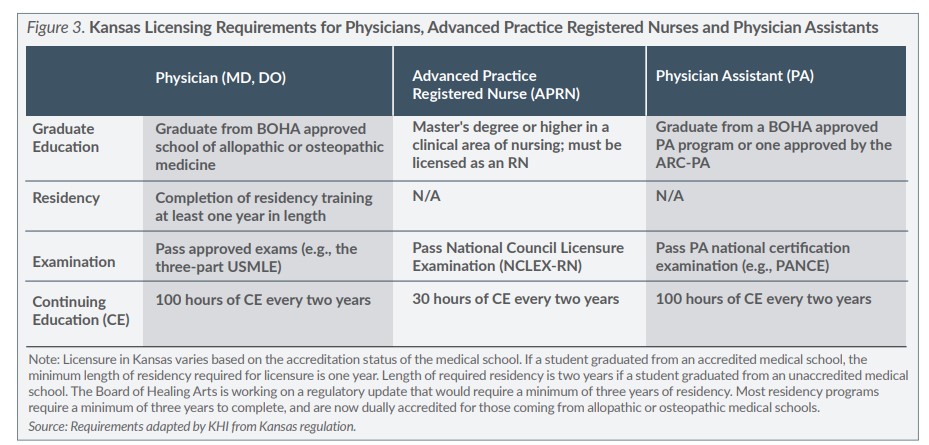This issue brief is the first of a two-part series examining the primary care workforce in Kansas. It describes the clinicians who comprise the primary care workforce in Kansas. The second brief, Implications of an Aging Primary Care Physician Workforce in Kansas, describes the age and geographic distribution of primary care physicians.
Introduction
Kansas, like the U.S. as a whole, is experiencing a shortage of primary care physicians. In 2018, the Health Resources and Services Administration (HRSA) indicated that 180 physicians were needed to eliminate the current primary care Health Professional Shortage Area (HPSA) designations in Kansas. While primary care physicians are not the only clinicians who provide primary care, Kansas statute requires nurse practitioners (NP) and physician assistants (PA) to practice according to an agreement with a physician.
What is Primary Care?
According to the National Academies of Sciences, Engineering, and Medicine (National Academies), primary care is “the provision of integrated, accessible health care services by clinicians who are accountable for addressing a large majority of personal health care needs, developing a sustained partnership with patients, and practicing in the context of family and community.” This definition also could apply to dental primary care and behavioral health, including in an integrated care setting.
Primary Care Workforce
According to the National Academies, the major types of primary care clinicians are physicians, PAs and NPs. In this issue brief, physician refers to individuals who attended an allopathic medical school (MD) or an osteopathic medical school (DO), and primary care physician specialties include family medicine, general internal medicine, geriatrics, general pediatrics and general practice. Hospitalists and other specialists, such as cardiologists or obstetricians/gynecologists, are not considered primary care physicians. While they might provide primary care for some populations, according to HRSA, “they are not engaged in activities that meet the [National Academies] definition of primary care.”
PAs specialize similarly to physicians, and in Kansas an estimated one-third of PAs specialize in primary care. Among advanced practice registered nurses (APRN), NPs most commonly practice primary care and are considered primary care clinicians in this issue brief. Nationally more than 75 percent of NPs specialize in primary care, and aggregate Kansas licensing data indicates the rate is similar, and potentially higher, in Kansas. Other APRNs in Kansas, including clinical nurse specialists, nurse anesthetists and nurse-midwives, are not considered primary care clinicians in this issue brief.
Licensure data from the Kansas State Board of Healing Arts and the Kansas State Board of Nursing, the best available data, was used to estimate the primary care workforce in Kansas in 2019. Currently, clinicians are not required by statute to report data such as secondary practice locations, how many hours per week they work and how many patients they treat. Consistent collection of this information is critical to better understanding the workforce in Kansas.
Clinicians were included in the estimate if their practice state was Kansas and if they reported one of the primary care specialties described earlier. Physicians with a primary care specialty were excluded if a web search revealed that they were a hospitalist. APRNs were included if they were licensed as an NP. Because PA specialty information was not available in the licensure data, the number of primary care PAs was estimated using the proportion of PAs in Kansas practicing primary care published by the National Commission on Certification of Physician Assistants (NCCPA). According to the NCCPA, 35.7 percent of PAs in Kansas were practicing primary care in 2018.



